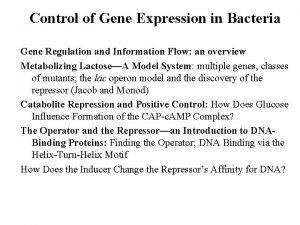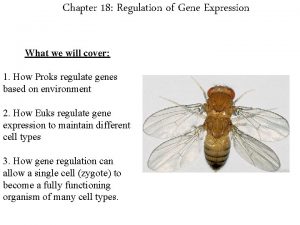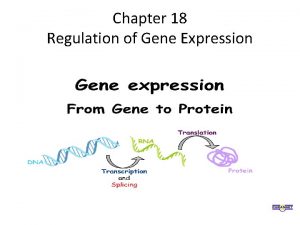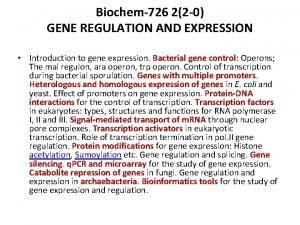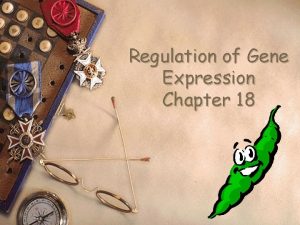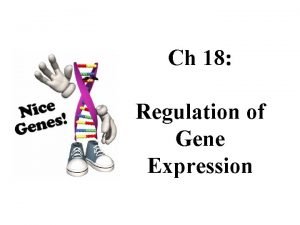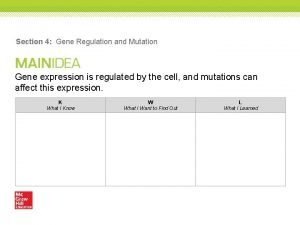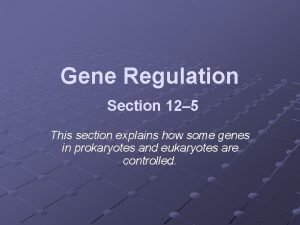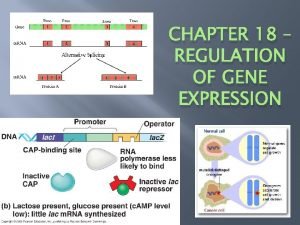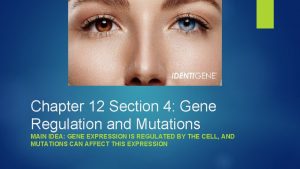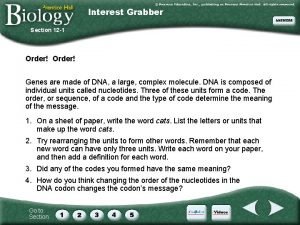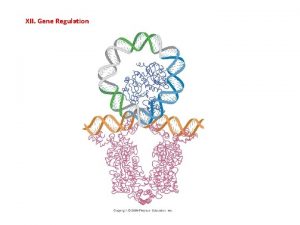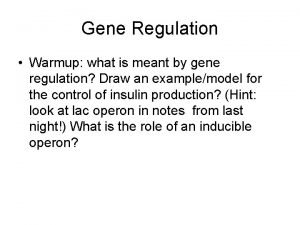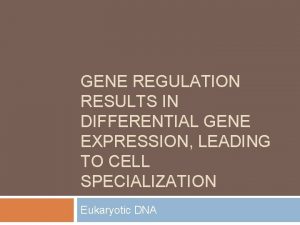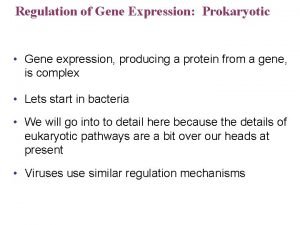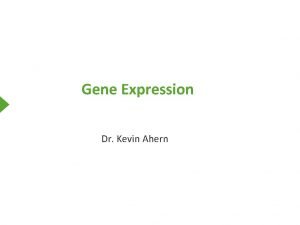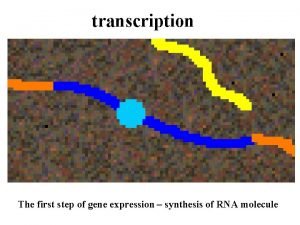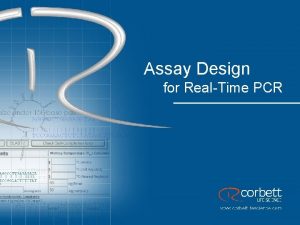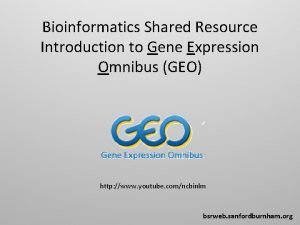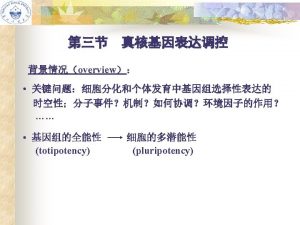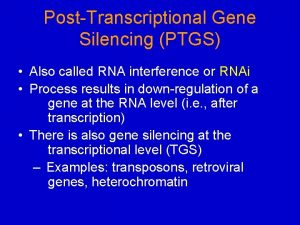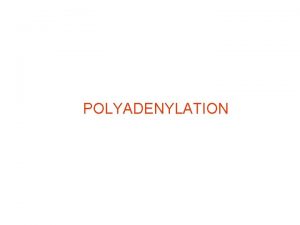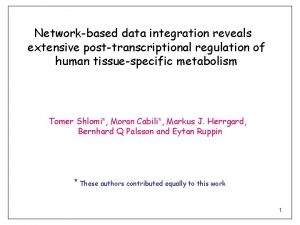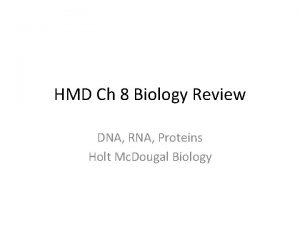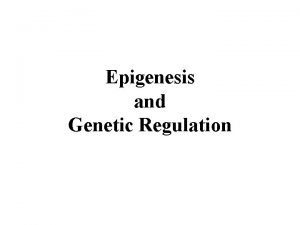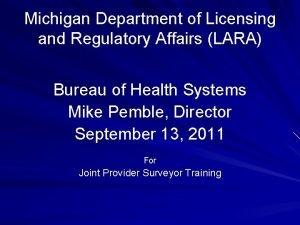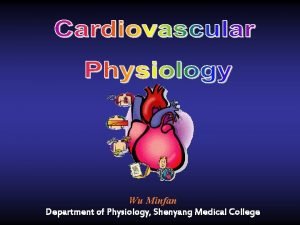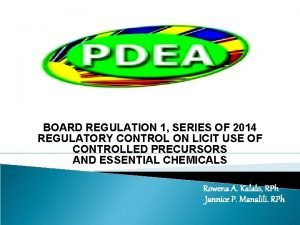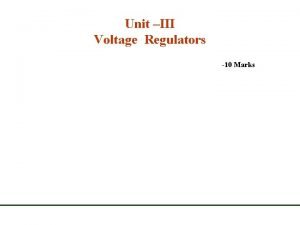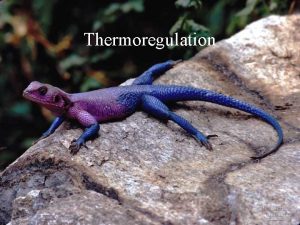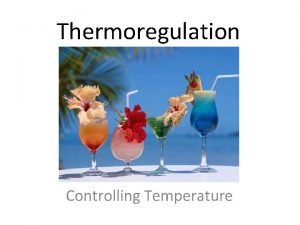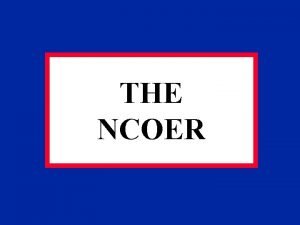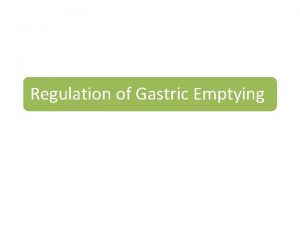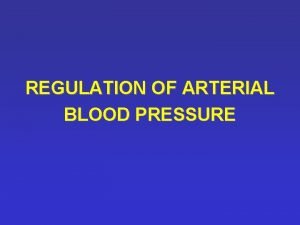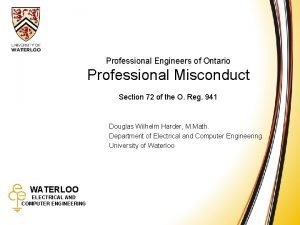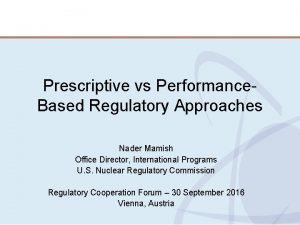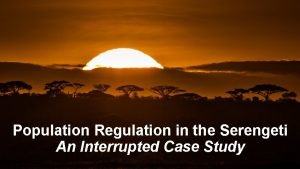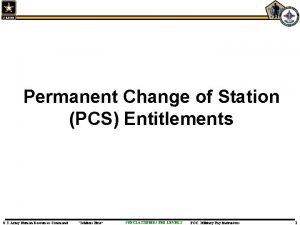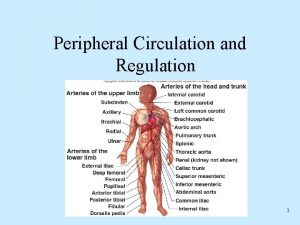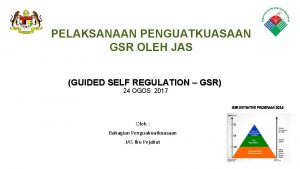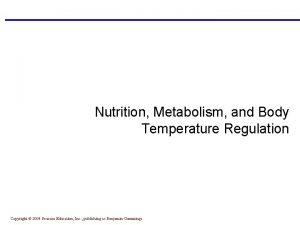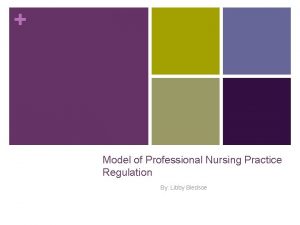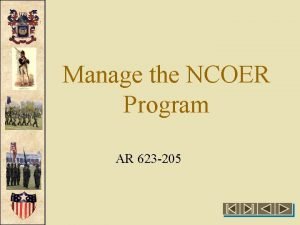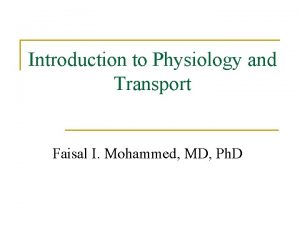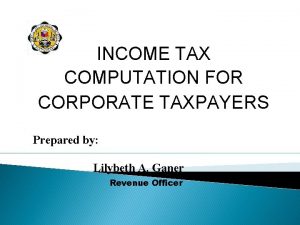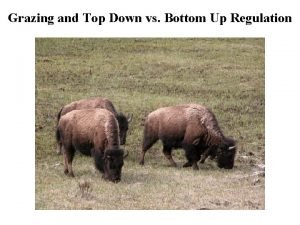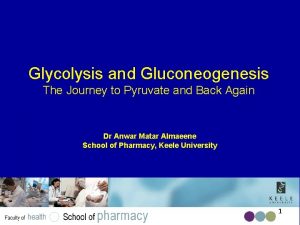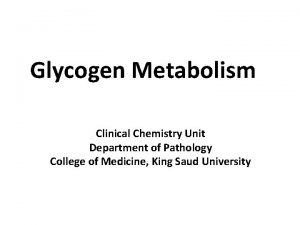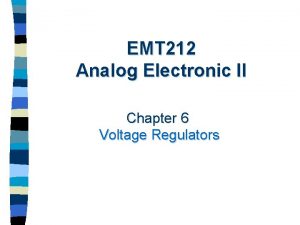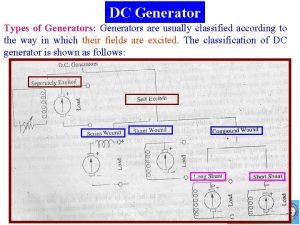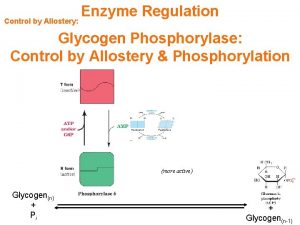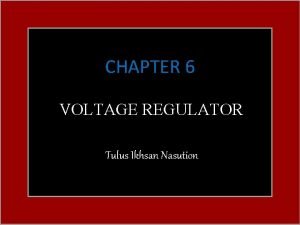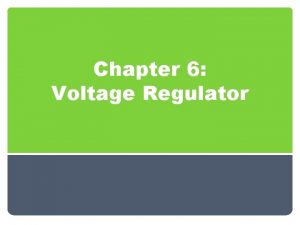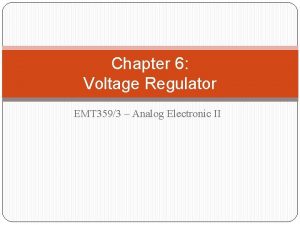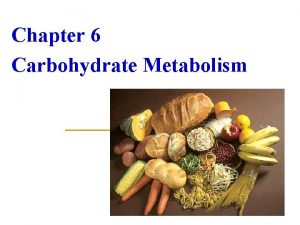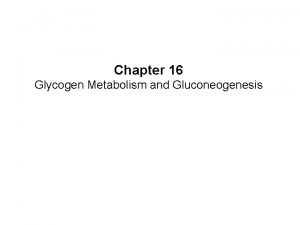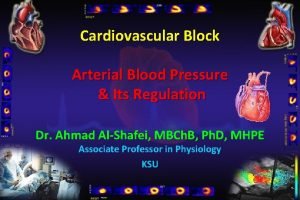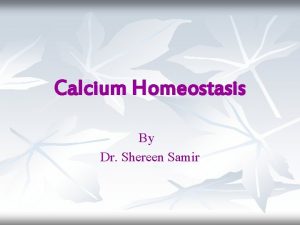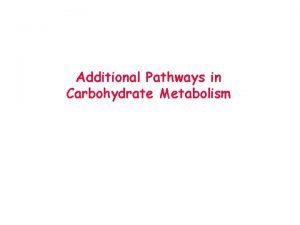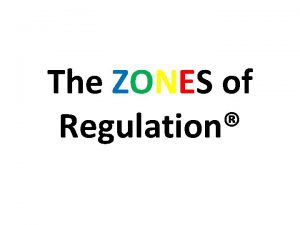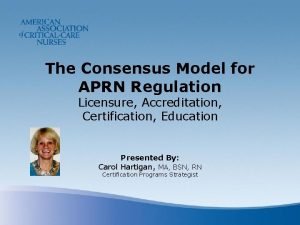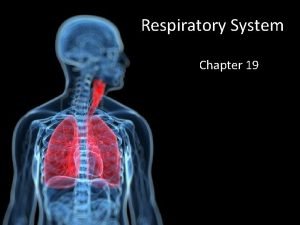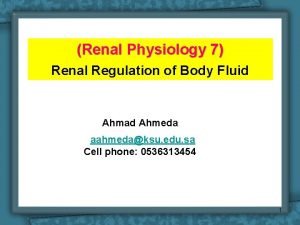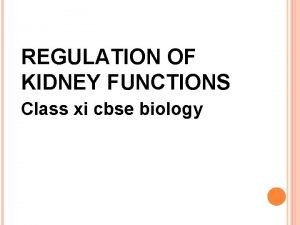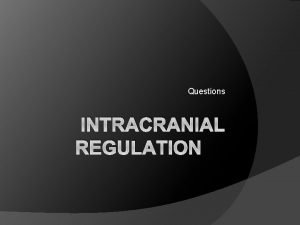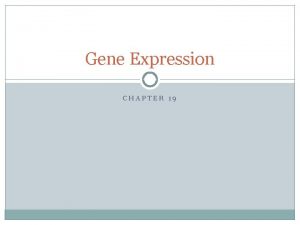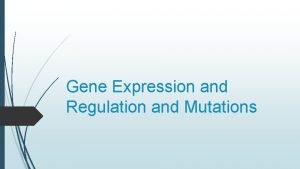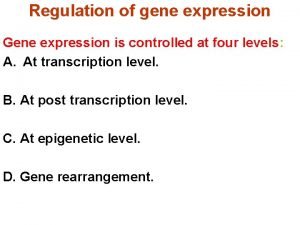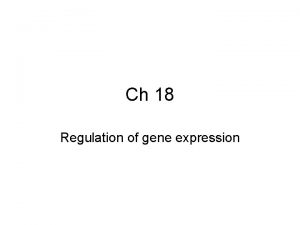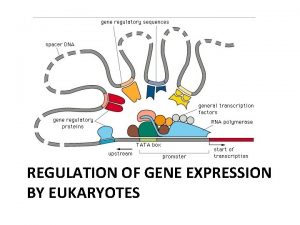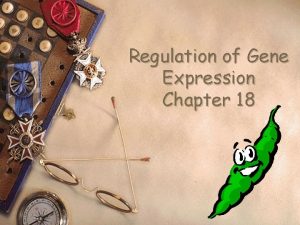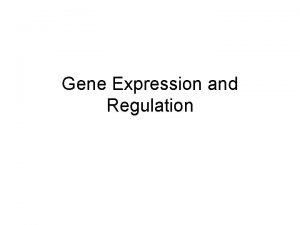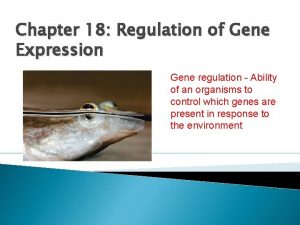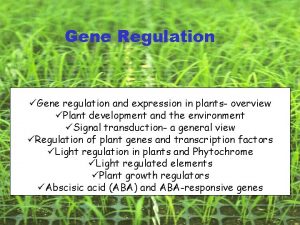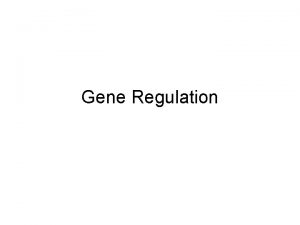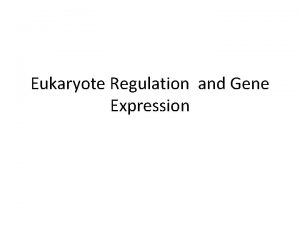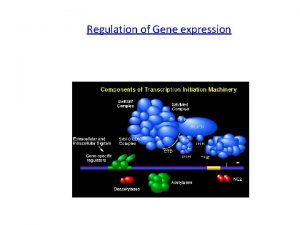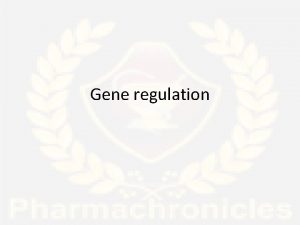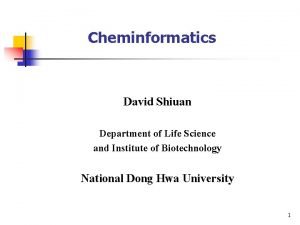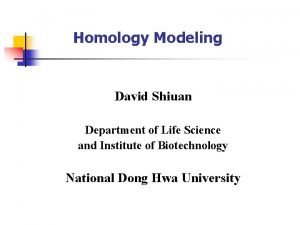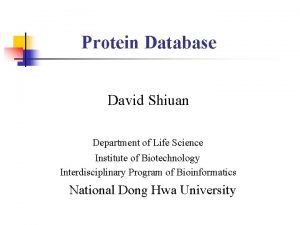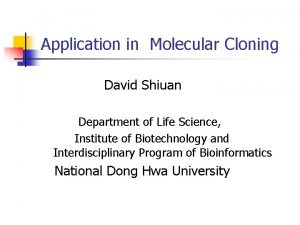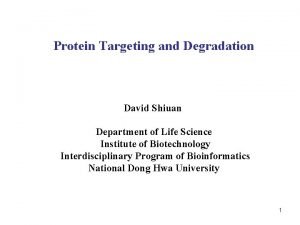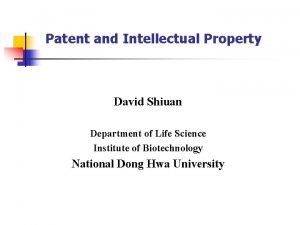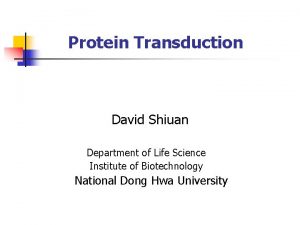Regulation of Gene Expression David Shiuan Department of






































































































- Slides: 102

Regulation of Gene Expression David Shiuan Department of Life Science Institute of Biotechnology Interdisciplinary Program of Bioinformatics National Dong Hwa University

The fundamental problem of chemical physiology and of embryology --- is to understand why tissue cells do not all express, all the time, all the potentialities inherent in their genome. Francois Jacob and Jacques Monod J. Mol. Biol. 1961

• 1. Principle of gene regulation • 2. Regulation of gene expression in prokaryotes • 3. Regulation of gene expression in eukaryotes

Seven processes affect the steady-state concentration of a protein

Potential Points of Regulation • Synthesis of primary RNA transcript (transcription) • Posttranscriptional modification of m. RNA • m. RNA degradation • Protein synthesis (translation) • Posttranslational modification of proteins • Protein targeting and transport • Protein degradation

1. Principle of gene regulation Molecular circuits ---------------House keeping genes; constitutive gene expression Inducible; induction; repressible; repression RNA polymerase binds to DNA at promoters

Consensus sequence for promoters that regulate expression of the E. coli heat shock genes






Many prokaryotic genes are clustered and regulated in operons

Lactose metabolism in E. coli

They published a paper - Coordinated regulation of lac operon, Proc. French Acad. Sci. (1960)

The lac operon

Lac repressor binds to operator O 2 and O 3

Lac repressor binds to operator (PDB-1 BLG)

Lac repressor binds to operator - Conformational change in the repressor caused by DNA binding

Lac inducer IPTG, structurally similar to lactose

Groups in DNA available for protein binding Shown in red- groups Can recognize proteins

Protein-DNA interactions

Relationship between the lac operator sequence O 1 and the lac promoter

DNA Binding Domain of Lac Repressor - Helix-turn-helix

Surface rendering of the DNA-binding domain gray - lac repressor; blue - DNA

The DNA-binding domain, but separated

The zinc-finger – each Zn 2+ coordinates with 2 His and 2 Cys residues

Homeodomain - approx. 60 aa Homeotic genes (genes that regulate the development of body patterns) DNA-Binding Domain - helix-turn-helix

Studying DNA-Protein Interactions • EMSA (electrophoretic mobility shift assay); or gel retardation assay • DNase. I footprinting experiment • DNA affinity chromatography • SPR (Surface Plasmon Resonance)/BIACORE • CD/ORD; Spefctrofluorometry; NMR

EMSA- M. hyopneumoniae Hrc. A-CIRCE Interaction 1 2 3 4 5

DNase. I Footprinting – JBBM 30 (1995) 85 -89

DNA Affinity Chromatography

Surface Plasmon Resonance (SPR) • SPR - Surface plasmon resonance is a phenomenon which occurs when light is reflected off thin metal films. A fraction of the light energy incident at a sharply defined angle can interact with the delocalized electrons in the metal film (plasmon) thus reducing the reflected light intensity


DNA-Binding Motif Comparison of aa sequences of several leucine zipper proteins

Leucine zipper from yeast activator protein (1 YSA)

Helix-loop-helix – the human transcription factor Max, bound to DNA target 1 HLO

2. Regulation of Gene Expression in Prokaryotes

Catabolic Repression - restricts expression of the genes required for catabolism of lactose, arabinose and other sugar in the presence of glucose

CRP (c. AMP Receptor Protein) homodimer - bound with c. AMP


The trp Operon

The trp Repressor

Transcriptional attenuation in the trp operon




SOS response in E. coli - Rec. A/ss. DNA cleaves repressor Lex. A

Translational feedback in some ribosomal protein operons Translation Repressor

Stringent response in E. coli – amino acid starvation uncharged t. RNA binds to A site Rel. A action pp. Gpp as starvation signal and regulate ~200 genes and r. RNA

Salmonella typhimurium with flagella Flagellin (MW 53 k. D) are the targets of mammalian Immune system Phase Variation Switch between two distinct flagellin (Flj. B, Flj. C) once 1000 generations

Regulation of flagellin genes in Salmonella : phase variation to evade the host immune response




3. Regulation of Gene Expression in Eukaryotes

Eukaryote Gene Regulation - Four Different Features 1. Eukaryotic promoter is restricted by the structure of chromatid 2. Positive regulation 3. More multimeric regulatory proteins 4. Transcription is separated from translation in both space and time

Transcriptionally Active Chromatin is Structurally Distinct from Inactive Chromatin • Heterochromatin - ~10% in eukaryotic cells, more condensed, transcriptionally inactive, generally associated with chromosome structure such as centormeres • Euchromatin - the remaining, less condensed chromatin • Hypersensitive Sites - in actively transcribed regions; many bind to regulatory proteins • Histones – different modifications in different regions

Histones – different modifications in different regions Nucleosome core proteins Modification – methylation, acetylation, attachment of ubiquitin

Histones act as a general repressor of transcription, because they interfere with protein binding to DNA 1. Histones form nucleosomes on TATA boxes, blocking transcription. Promoter-binding proteins cannot disrupt the nucleosomes. Enhancer-binding proteins bind to enhancers, displacing any histones, and then cause the histones at the TATA box to free the DNA. 2. Histone Acetylation with increased transcription. Histone are acetylated on lysines in regions on the outside of the nucleosome. Acetylation destabilizes higher-order chromatin structure. DNA becomes more accessible to transcription factors, and overcoming histone repression of transcription.

DNA Methylation 1. DNA methylation and transcription are correlated, with lower levels of methylated DNA in transcriptionally active genes. 2. Other recent observations also indicate a role for methylation in gene expression: (a) A methylase is essential for development in mice. (b) Methylation is involved in fragile X syndrome, where expansion of a triplet repeat and abnormal methylation in the FMR-1 gene silence its expression.

Chromatin Remodeling – detailed mechanisms for transcription-associated structural changes in chromatin

Acetylation in histone H 3 globular domain regulate gene expression in Yeast Cell 121 (2005) 375 • Lys 56 in histone H 3 : in the globular domain and extends toward the DNA major groove/nucleosome • K 56 acetylation : enriched at certain active genes, such as histones

Acetylation in histone H 3 globular domain regulates gene expression in yeast Cell 121(2005) 375 • SPT 10, a putative acetyltransferase: required for cell cycle-specific K 56 acetylation at histone genes • Histone H 3 K 56 acetylation at the entry-exit gate enables recruitment of the SWI/SNF nucleosome remodeling complex and so regulates gene activity

The RNA degradosome TIBS 31 (2006) 359 -365 • Most m. RNA molecules are destroyed shortly after synthesized • In E. coli, a multi-enzyme complex RNA degradosome can drive the energy-dependent turnover of m. RNA and trim RNA species into their active forms • Degradosome comprises : 1. endoribonuclease RNase E : initiates the m. RNA turnover 2. ATP-dependent RNA helicase Rhl. B : unwinds and translocates RNA 3. glycolytic enzyme : Enolase 4. phosphorolytic exoribonuclease : PNPase

(a) Structure of RNase. E/RNase. G (b) The protein-RNA recognition domain

The structural information for components of the E. coli RNA degradosome and a model of degradosome assembly

Alternative pre-m. RNA splicing TIBS 25 (2000) 381 -388 Different modes of alternative splicing and its consequences

Splice-site elements and splicing complex assembly

Packing and Remodelling RNA • Primary transcripts associate with a family of polypeptides known as hn. RNP proteins • They contain RNA-binding motifs, and Gly-rich domains for protein–protein interactions and RNA transport • hn. RNP packaging can also bring together distant regions of the pre-m. RNA and therefore assist splicesite pairing

Post-transcriptional control of gene expression: a genome-wide perspective TIBS 30 (2005) 506 -514

Many eukaryotic promoters are positively regulated • RNA polymerases have little or no intrinsic affinity for promoters • Transcription initiation depends on activator proteins • Enhancer; Upstream Activator Sequence (UAS, Yeast) • Basal transcription factors – RNA pol II DNA-binding transactivator – enhancer Coactivator – interconnections Repressors -

Eukaryotic promoters and regulatory proteins

Eukaryotic transcriptional repressor

Galactose-utilization genes of yeast GAL 1 galactokinase. GAL 7 galactose transferase. GAL 10 galactose epimerase


Regulation of galactose metabolism in yeast

Activation of Yeast Gal Genes

Protein complexes involved in transcription activation of a group of related eukaryotic genes (yeast Gal system)



DNA-binding transactivators DNA-binding domain and activation domain

DNA-binding transactivators DNA-binding domain of Sp 1 and the activator domain of CTF 1 activates transcription of a GC box chimeric protein

Eukaryotic gene expression can be regulated by intracellular and extracellular signals • Steroid hormone – extracellular signal bind to intracellular receptor hormone-receptor complex binds to HRE (hormone-response elements) • Regulation through phosphorylation of transcription factors – intracellular signal


Typical steroid hormone receptors

Translational Regulation 1. Phosphorylation of initiation factor less active 2. Protein repressor bind to 3’UTR of m. RNA to prevent translation initiation 3. Binding proteins disrupt the interaction of el. F 4 E and el. F 4 G to prevent the formation of eukaryotic initiation complex

Phosphorylation of initiation factors -Regulation of Gene Expression by Insulin

Translational regulation of eukaryotic m. RNA (1) el. F interactions (2) 3’UTR binding

Post-transcriptional gene silencing by RNA interference (endonuclease)

Development is controlled by cascades of regulatory proteins - life cycle of fruit fly 幼蟲 蛹

Development is controlled by Cascades of Regulatory Proteins • Polarity (anterior/posterior; dorsal/ventral) • Metamerism (serially repeating segments) • Pattern regulating genes – morphogens 1. maternal genes (expressed in unfertilized eggs) 2. segmentation genes (gap; pair-rule; segment polarity) 3. homeotic genes (expressed later to organs)

Early development in Drosophila




Distribution of a maternal gene product in a Drosophila egg An immunologically stained egg, showing the distribution of bicoid (bcd) gene product

If bcd gene is not expressed by the mother (bcd- mutant) thus No bcd m. RNA is deposited in the egg, the resulting embryo has Two posteriors (and soon die)

Regulatory circuits of the anterior-posterior axis in a Drosophila egg

Distribution of the fushi tarazu (ftz) gene product in early Drosophila embryos

Homeotic Genes • Homeotic genes - genes that regulate the development of body patterns • Homeodomain - approx. 60 aa; helix-turn-helix; • Homeobox - DNA part • Ultrabithrax (ubx) gene: 76 kb (73 kb intron) Ubx protein is transcriptional activator

Effects of mutation in homeotic genes in Drosophila
 Regulation of gene expression
Regulation of gene expression Chapter 18 regulation of gene expression
Chapter 18 regulation of gene expression Chapter 18 regulation of gene expression
Chapter 18 regulation of gene expression Regulation of gene expression
Regulation of gene expression Chapter 18 regulation of gene expression
Chapter 18 regulation of gene expression Chapter 18 regulation of gene expression
Chapter 18 regulation of gene expression Chapter 17 from gene to protein
Chapter 17 from gene to protein Section 4 gene regulation and mutation
Section 4 gene regulation and mutation Gene regulation
Gene regulation Section 12-5 gene regulation
Section 12-5 gene regulation Prokaryotes vs eukaryotes gene regulation
Prokaryotes vs eukaryotes gene regulation Chapter 12 section 4 gene regulation and mutations
Chapter 12 section 4 gene regulation and mutations Section 12-1 dna
Section 12-1 dna What is gene regulation
What is gene regulation Gene regulation
Gene regulation Differential gene regulation
Differential gene regulation Negative vs positive control operon
Negative vs positive control operon Gene by gene test results
Gene by gene test results Prokaryotic gene expression
Prokaryotic gene expression Prokaryotic
Prokaryotic טרנסלציה
טרנסלציה Genetic effects on gene expression across human tissues
Genetic effects on gene expression across human tissues Taq polymerase
Taq polymerase Gene expression omnibus tutorial
Gene expression omnibus tutorial Gene expression
Gene expression Gene expression
Gene expression Gene expression
Gene expression Gene expression
Gene expression Cells must control gene expression so that __________.
Cells must control gene expression so that __________. Lyonization of gene expression
Lyonization of gene expression Ponzi scheme vs pyramid scheme
Ponzi scheme vs pyramid scheme Hines hill train crash
Hines hill train crash Michigan department of licensing and regulation
Michigan department of licensing and regulation Quadratic formula
Quadratic formula David gene functional classification tool
David gene functional classification tool Homometric regulation of cardiac output
Homometric regulation of cardiac output Board regulation 1 series of 2014
Board regulation 1 series of 2014 Line regulation
Line regulation Navy ponytail regulation
Navy ponytail regulation Regulation of tubular reabsorption
Regulation of tubular reabsorption Homeostasis mechanisms for regulation of body temperature
Homeostasis mechanisms for regulation of body temperature Homeostasis mechanisms for regulation of body temperature
Homeostasis mechanisms for regulation of body temperature Zones of regulation stop opt go
Zones of regulation stop opt go Ar 623-2
Ar 623-2 Army bah regulation 608 99
Army bah regulation 608 99 Basic rules and regulations of table tennis
Basic rules and regulations of table tennis Gastric emptying is promoted by
Gastric emptying is promoted by Regulation of arterial blood pressure
Regulation of arterial blood pressure Section 72 of regulation o.reg.941
Section 72 of regulation o.reg.941 Prescriptive vs performance-based regulation
Prescriptive vs performance-based regulation Malaysia elv regulation
Malaysia elv regulation Serengeti
Serengeti Ar 623 3
Ar 623 3 Jtr, section 0506
Jtr, section 0506 Is blood flow turbulent or laminar
Is blood flow turbulent or laminar Guided self regulation
Guided self regulation Co-regulation
Co-regulation Nutrition metabolism and body temperature regulation
Nutrition metabolism and body temperature regulation How there is recyclability and self-regulation in nature
How there is recyclability and self-regulation in nature Model of professional nursing practice regulation
Model of professional nursing practice regulation Ngr 635-100
Ngr 635-100 Ncoer regulation ar 623-205
Ncoer regulation ar 623-205 Regulation of blood pressure negative feedback
Regulation of blood pressure negative feedback Personal income tax computation
Personal income tax computation Ifr altitudes
Ifr altitudes Outcomes focused regulation
Outcomes focused regulation Bottom up regulation
Bottom up regulation Reversible reactions in glycolysis
Reversible reactions in glycolysis Glycogen location
Glycogen location Down regulation recettoriale
Down regulation recettoriale Line regulation formula
Line regulation formula Deviance regulation theory
Deviance regulation theory Nco duties and responsibilities regulation
Nco duties and responsibilities regulation Demagnetizing and cross magnetizing
Demagnetizing and cross magnetizing Cimah regulation 1996
Cimah regulation 1996 Glycogen regulation
Glycogen regulation Collision regulation
Collision regulation China elv regulation
China elv regulation Regulation of recruitment and placement activities
Regulation of recruitment and placement activities Series voltage regulator block diagram
Series voltage regulator block diagram Voltage regulator purpose
Voltage regulator purpose Line regulation formula
Line regulation formula Krebs cycle regulation
Krebs cycle regulation Production of glycogen
Production of glycogen How to calculate mean arterial pressure
How to calculate mean arterial pressure Normal ca level in blood
Normal ca level in blood Short term regulation of blood pressure
Short term regulation of blood pressure Pep carboxykinase
Pep carboxykinase Expanded withholding tax revenue regulation
Expanded withholding tax revenue regulation Why is ammonia toxic
Why is ammonia toxic Zones of regulation videos
Zones of regulation videos Consensus model for aprn regulation
Consensus model for aprn regulation Rules and regulation in table tennis
Rules and regulation in table tennis Regulation
Regulation Regulation of body fluids
Regulation of body fluids Topper learning.com
Topper learning.com Regulation and inspection of social care wales
Regulation and inspection of social care wales Intracranial regulation nursing
Intracranial regulation nursing Difficulty in emotion regulation scale
Difficulty in emotion regulation scale Line regulation
Line regulation Occupational health and safety act ontario
Occupational health and safety act ontario Legislation vs regulation
Legislation vs regulation Ar 600-8-10
Ar 600-8-10
